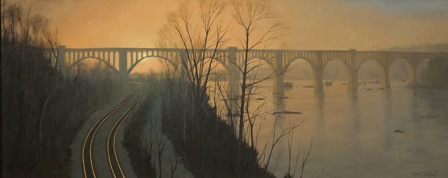By Betsy DiJulio
Intrigued that a show by an architect turned professional landscape painter—who also happens to play award-winning fiddle and banjo—was on view this winter at Virginia Wesleyan College’s Neil Britton Gallery and would be accompanied by a roots music concert series, I contacted curator and art professor, John Rudel, for details.
From our first exchange, I became as intrigued by what Rudel had to say about artists’ responses to the landscape, as by the show itself, including that it was not curated by him, but by VWC history professor, Dan Margolies, Ph.D. (More on him at the end.)
In providing me with an overview of the show via email before we met at the gallery, Rudel noted: “I think (Campbell’s) music and paintings both reflect a very specific sense of place.” This prompted my response of, “Is there landscape painting that is not about a sense of place?,” as it seems that the phrase “sense of place” has been bandied about in art and literature to the point of near cliché.
And it seems that the answer depends on how one defines place. If we mean an actual, faithfully reproduced place, then that is rather hard to come by, appearances to the contrary. And, furthermore, it always has been thanks to “POV” or the artist’s point of view. As Rudel reminded me, even the so-called “realistic” Hudson River School painters of the 19th century “created fictional landscapes through amalgamations, not specific places…they were about ‘sublime;’” and, I might add, about endorsing the doctrine of manifest destiny.
But if we mean a constructed—and, nowadays, technologically-mediated—“place,” then the field widens.
With titles like “Belle Isle Morning” and “Reflection on the James,” Campbell chronicles en plein air—who does that anymore, especially at this scale (24 x 60”)?—highly specific locales, hung in order from the western most images to the eastern most, tracing the James River across the Commonwealth. Camouflaged flecks of dirt and gravel embedded in the surfaces attest to the paintings having been created—and fallen over—on site.
After spending his youth in the Shenandoah Valley, Campbell studied art and architecture at the University of Virginia in the 1970s and painting, briefly, at Virginia Commonwealth University. A career as an architect with Circuit City—who’s door-closing paved the way for Campbell to turn to painting full time—is betrayed in his Virginia Landscapes.
As Rudel pointed out, “He was an architect by trade and his landscape paintings have a terrific underlying use of linear perspective that give them a very exacting sense of depth, while his interpretation of color and light is nicely naturalistic and painterly. He is a ‘plein air’ painter. He is a back-to-the-roots artist in his painting and music.”
As much as his use of an inescapable linear perspective, Campbell’s tendency to eschew atmosphere in favor of an appealing, highly structural and solid interpretation of the land, water, and sky betrays his architectural training. Having perceived something of Hopper’s impenetrable and sturdy geometric cityscapes in Campbell’s treatment of the land, I was gratified to see that he references Hopper in his artist’s statement.
Then there is the light quality, the importance of which was apparently imprinted on Campbell while at UVA during a lecture by renowned architect, Lou Khan. As the story goes, he looked into Mark’s youthful eyes and said, “But…light is the most important thing.” And it stuck, though we’ll stop short of calling Cambpell “the painter of light,” with its negative Thomas Kinkade associations.
Warming to the occasion and revealing his academically-minded hand, Rudel continued our exchange: “I am really interested in the landscape discussion. In case you couldn’t tell J.” When I pressed, asking whether he had perceived another “layer” in Campbell’s work, he responded with: “The other layer might settle out into the argument for the communicative power of non-photographically mediated perception and documentation. The physical human engagement, the meditative gaze, the reverberation of direct perception over time? I’m probably not ready to flesh that out but these (Campbell’s paintings) are the opposite side of the spectrum from filtered Instagram photos. – Maybe.”
Rudel went on to explain that Campbell’s work is driven by an impulse quite at odds, at some levels, with many contemporary artists: “I think there is a lot of contemporary treatment of landscape that is much more about experience of space than about specific places. Lots about mapping and perception and abstraction.” As cases in point, he referenced the ground-breaking (pun intended) work of Cheryl Goldsleger, Kathryn Refi, and Aaron Koblin (see his TED Talk at http://www.ted.com/talks/aaron_koblin?language=en).
In closing, let’s return to Margolies for a moment. Lest the slate of traditional music concerts appear to be merely entertaining complementary programming—though it will provide entertainment aplenty—it is worth noting that a serious academic pursuit underlies this matchup. Margolies’ study of music in relation to “scapes” is deeply rooted in his scholarship. As an example, in 2010, he was awarded a Faculty Fellowship from the American Center for Mongolian Studies to study in situ “traditional music making and the ways traditional music is inscribed on the urban and rural soundscape…”
Perhaps Goldsleger best defines this connection between art, culture, and place: “…the spaces we know and inhabit have as profound an impact on us as we do on them…filled with invisible history and tension…that sense of timeless existence and the accrual of experiences…ideas about isolation, communication, human interaction and time.”
Mark C. Campbell: The James River from the Mountains to the Sea
Through February 5
Neil Britton Gallery, Virginia Wesleyan College
1584 Wesleyan Drive, Norfolk, 757.455.3257
http://www.vwc.edu/the-arts-at-virginia-wesleyan-college/neil-britton-gallery.php
Old Time Music Performances
Erynn Marshall (old time fiddle) and Carol Jones (mandolin, guitar, banjo): Old Time Appalachian Duet, Blocker Auditorium http://dittyville.com/
Thursday, January 22, 7:30 pm; Sponsored by Winter Session




